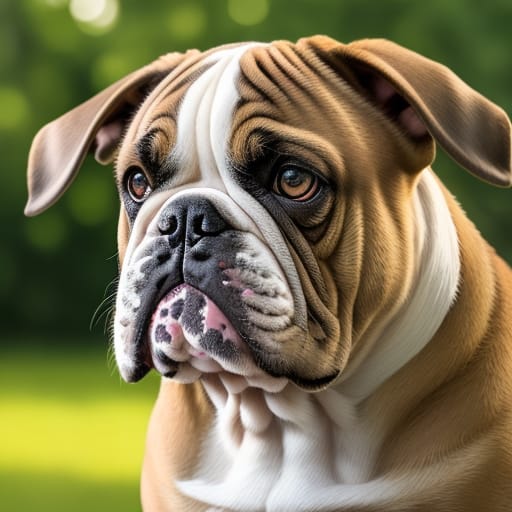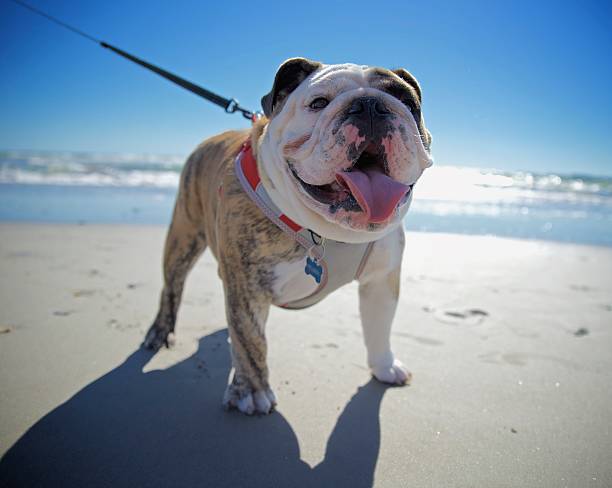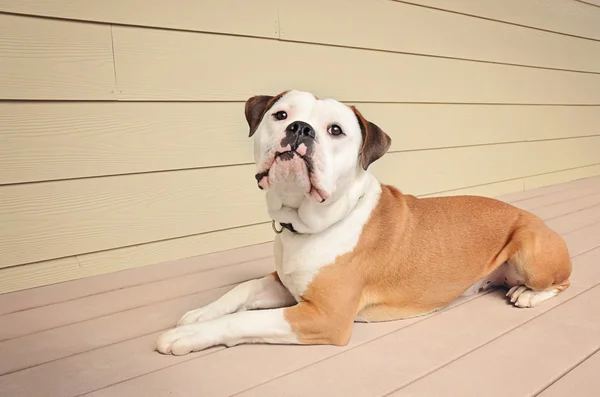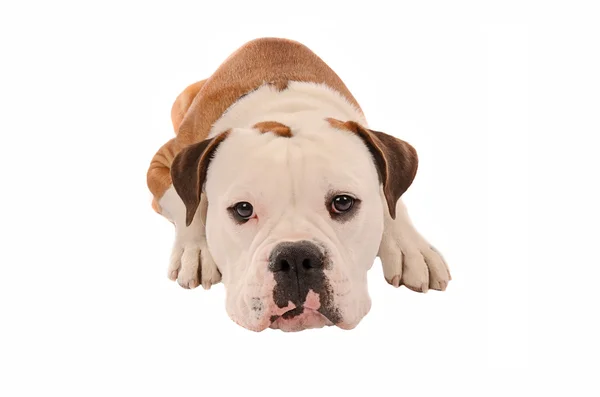The Olde English Bulldogge, a testament to strength and resilience, resonates deeply with dog aficionados and families alike. With its rich historical roots, robust physique, and loyal character, this breed has earned its place as a treasured companion and a tribute to the heritage of the English Bulldog.

| Category (Explanation) | Breed Information |
|---|---|
| Year of Breed Conception | 1970s (Developed in the United States) |
| Country of Origin | United States |
| Weight (Male) | 80-130 lbs (36-59 kg) |
| Weight (Female) | 70-120 lbs (32-54 kg) |
| Coat Type | Short, dense, and smooth |
| Color Variations | Various, including brindle, fawn, red, black, and more |
| Shedding Level (Low, Moderate, High) | Low |
| Height (cm & in) | 17-20 inches (43-51 cm) |
| Breed Size | Large |
| Trainability (Low, Moderate, High) | Moderate |
| Mental Needs (Low, Moderate, High) | Moderate |
| Intelligence Level (Low, Moderate, High) | Moderate |
| Energy Level (Low, Moderate, High) | Moderate |
| Agility (Low, Moderate, High) | Moderate |
| Loyalty (Low, Moderate, High) | High |
| Playfulness (Low, Moderate, High) | Moderate |
| Exercise Needs | Regular exercise and playtime |
| Guarding Proficiency (Low, Moderate, High) | High |
| Sociability with Children (Low, Moderate, High) | High |
| Barking Level (Low, Moderate, High) | Moderate |
| Digging Tendency (Low, Moderate, High) | Low |
| Destructive Behavior (Low, Moderate, High) | Low |
| Drooling Level (Low, Moderate, High) | Low |
| Obedience Level (Low, Moderate, High) | Moderate to high |
| Apartment Friendly (Yes/No) | Yes, with sufficient exercise |
| Inherent Prey Drive | Low |
| Physical Risk to Others (Low, Moderate, High) | Low |
| Travel Fatality Risk (Low, Moderate, High) | Low |
| Allergen Potential | Low (considered hypoallergenic) |
| Health Concerns (List of Common Health Concerns) | Hip Dysplasia, Bloat, Skin Issues |
| Average Life Expectancy (Life Expectancy in Years) | 9-14 years |










































































Woof Mastery is reader supported and our articles may contain affiliate links.
Instead of running third party ads that we have no control of we only use links from high-quality companies we are directly partnered with. Making use of these links come at no cost to you our reader, and in many cases have the extra benefit of discounted rates or sign up bonuses.
If you’re interested you can read more about our affiliate policy here.
We appreciate your support and always insure that the products and services we recommend are high-quality, helpful and relevant to the subject at hand!
The Olde English Bulldogge’s history is a tale of revival and restoration. In the 17th century, Bulldogs in England were bred for bull-baiting, a brutal and dangerous sport. However, as society evolved and animal cruelty laws were enacted, the breed faced the threat of extinction.
In the mid-20th century, a visionary breeder named David Leavitt embarked on a mission to recreate the historic Bulldog. He meticulously selected dogs from various breeds, including English Bulldogs, Bullmastiffs, American Bulldogs, and American Pit Bull Terriers, to achieve his goal.
Leavitt’s aim was to develop a healthier, more athletic Bulldog while preserving its distinctive appearance and amiable temperament. The result was the Olde English Bulldogge, a breed that pays homage to the original Bulldog’s heritage while embodying modern health and vitality.
Today, Olde English Bulldogges are cherished for their strength, loyalty, and their connection to the historical legacy of bulldog breeds.

What sets the Olde English Bulldogge apart is its dedication to preserving the traditional bulldog qualities. This breed embodies the look and spirit of the historical English Bulldog while promoting better health and athleticism.
Olde English Bulldogges are known for their muscular build, loyalty, and versatility. They balance a classic appearance with improved well-being, making them special to those who appreciate a classic bulldog with a focus on health and vitality.
Olde English Bulldogges were bred to recreate the historic Bulldog. They excel as loyal family companions and working dogs.
Olde English Bulldogges are renowned for their loyalty and protective instincts. They are affectionate towards their families and are particularly good with children. Their determined nature makes them trainable, and they are known for their devotion to their owners.
These dogs are known for their confidence and courage, making them excellent watchdogs. Despite their imposing appearance, Olde English Bulldogges are gentle giants when it comes to interacting with their loved ones.
They thrive on companionship and enjoy being part of an active family where they can participate in various activities. Olde English Bulldogges are also known for their strong work ethic, which stems from their historical roots as working dogs. They are driven and reliable, traits that endear them to families seeking both a loving companion and a protector.
Olde English Bulldogges often embody a loyal and protective temperament. Their love for their families is evident, and they tend to be affectionate and deeply attached. While protective instincts may surface, training and socialization are key to preventing overprotectiveness or aggression towards strangers.
Territorial behavior and occasional stubbornness can be managed effectively with consistent and patient training techniques. Due to their strength, leash training is imperative to maintain control. Careful introductions are essential when socializing with other dogs, especially those of the same sex.
Early training and socialization play a pivotal role in fostering a well-adjusted and balanced temperament in this breed. Olde English Bulldogges are renowned for their gentle yet protective nature, making them ideal companions for those seeking a devoted and vigilant pet.
Olde English Bulldogges are medium to large-sized dogs known for their robust and athletic build. They feature a square-shaped head with a broad, well-defined jaw and powerful cheeks, which contribute to their determined and confident expression.
Their eyes are typically round and dark, reflecting their alertness. Ears can be natural or cropped, based on individual preference. These dogs possess a short, dense coat that comes in various colors, often with striking brindle patterns.
This coat not only enhances their distinctive look but also accentuates their muscular and athletic physique. Olde English Bulldogges boast a robust neck, leading to a broad chest and sturdy, straight legs. Their tail is typically straight or may have a slight curve.
In terms of size, males typically stand between 17 to 20 inches (43-51 cm) at the shoulder, while females are slightly smaller. Weight ranges from 50 to 80 pounds (23-36 kg) for males, with females being lighter.
Overall, Olde English Bulldogges project an athletic and confident presence. They have a history as working and guarding dogs, and their appearance exudes strength, courage, and a loyal temperament, making them a reliable choice for families seeking a protective and devoted companion.
Olde English Bulldogges come in various color variations, contributing to their rugged and muscular look. The most common color varieties for Olde English Bulldogges include:
Olde English Bulldogges have a moderate shedding level. While they are not heavy shedders, they do shed year-round, with shedding often increasing during seasonal changes. Regular grooming and brushing with a bristle brush or a deshedding tool once or twice a week can help control shedding and promote a healthier coat.
Factors that can affect shedding in Olde English Bulldogges can be influenced by genetics, coat care, and health. Ensuring your Bulldogge gets regular exercise and maintaining a consistent grooming routine can help manage shedding and keep their coat in good condition.
Olde English Bulldogges have a short, low-maintenance coat.
Brushing: Regular brushing once or twice a week helps keep their coat in good condition and reduces shedding.
Bathing: Occasional baths are sufficient; avoid over-bathing to preserve natural oils. Use a mild dog shampoo.
Ears: Check and clean their ears regularly to prevent wax buildup or infections. Use a damp cotton ball or a veterinarian-recommended ear cleaning solution.
Nails: Keep their nails trimmed to a comfortable length to prevent discomfort. Teeth: Brush their teeth regularly to maintain good oral hygiene and prevent dental issues. Dental chews or toys can also help.
Wrinkle Care (if applicable): If your Olde English Bulldogge has wrinkles, ensure they are clean and dry between the folds to prevent skin issues. Gently clean and dry as needed.
Eye Care: Monitor their eyes for any signs of irritation or discharge and clean around the eye area if necessary.
Olde English Bulldogges have a moderate activity level. They are a muscular and agile breed. Here are some key points to consider about their activity level:
Exercise Needs: Olde English Bulldogges benefit from daily exercise, including brisk walks, playtime, and activities that engage their physical abilities.
Energy Level: They have moderate energy levels and enjoy being active. They can participate in various physical activities and sports.
Physical Activity: Their strong build allows them to excel in activities like agility and obedience. Regular exercise helps them maintain a healthy weight.
Mental Stimulation: Mental stimulation through training and puzzle toys can prevent boredom and keep their minds sharp.
Exercise Caution: Be mindful of their activity in extreme heat or cold due to their short muzzle. Ensure they have access to water during exercise in hot weather.
Age Consideration: As Olde English Bulldogges age, their exercise needs may change, so adapt their routine to their age and physical condition.
Olde English Bulldogges exhibit a moderate level of intelligence, which complements their strong and athletic build. Here are some key points about their intelligence:
Olde English Bulldogges may not rank among the most intellectually demanding breeds, but their moderate intelligence, combined with their loyalty and protective nature, makes them excellent family pets and working dogs. Proper training and socialization are essential for their well-rounded behavior.
The Olde English Bulldogge enjoys activities that challenge their intellect. Toys that encourage them to think or interactive play sessions can be beneficial.
Social Interaction: They form deep bonds with their families and require regular interaction to stay emotionally balanced.
Exercise: Physical activities like walks or playtime in the yard can keep their minds active and reduce stress.
Training and Obedience: Engaging them in training exercises not only mentally stimulates them but also fosters a closer relationship with their owner.
Routine and Structure: A predictable daily routine gives the Olde English Bulldogge a sense of security and calm.
Affection and Attention: These Bulldogs thrive on affection and look forward to quality time spent with their family.
Socialization: Early experiences with diverse environments and creatures shape their social skills and confidence.
Safe Environment: A comfortable home space where they can retreat and feel safe is paramount for their well-being.
Consistency: Regularity in their daily schedule and training approach ensures they remain balanced and happy.
Enter The Woof Mastery

Before bringing an Olde English Bulldogge into your home, it’s crucial to recognize their needs. These dogs are known for their athletic build and strong, protective instincts. They require regular exercise and mental stimulation to stay healthy and happy.
Training and socialization are essential to manage their protective nature. Be prepared for potential health issues like hip dysplasia. Grooming requirements are relatively low. Responsible ownership involves creating a secure and loving environment to cater to the needs of these loyal and energetic companions.
Olde English Bulldogges, being a resilient breed, have the potential to pose a physical danger if they aren’t properly socialized, trained, or managed. Behavior largely reflects factors like individual temperament, upbringing, training, and owner responsibility. Here’s their potential physical danger breakdown:
Olde English Bulldogges are renowned for their loyalty and protective instincts. They are affectionate towards their families and are particularly good with children. Their determined nature makes them trainable, and they are known for their devotion to their owners. These dogs are known for their confidence and courage, making them excellent watchdogs.
Despite their imposing appearance, Olde English Bulldogges are gentle giants when it comes to interacting with their loved ones. They thrive on companionship and enjoy being part of an active family where they can participate in various activities.
Olde English Bulldogges are also known for their strong work ethic, which stems from their historical roots as working dogs. They are driven and reliable, traits that endear them to families seeking both a loving companion and a protector.
Olde English Bulldogges are more athletic and agile compared to English Bulldogs, but their swimming ability can vary. Here are some factors to consider:
Some Olde English Bulldogges can swim, but always evaluate your individual dog’s comfort and abilities in water. After all, each dog is different from the other, and this breed is quite skittish.
Training an Olde English Bulldogge puppy requires an understanding of their energetic and sometimes obstinate character. With persistent and positive training, they will develop into disciplined and loving companions.
Olde English Bulldogges, like every dog breed, have a range of vocalizations they use as a form of expression and communication. Here’s what you might hear from them:
Being aware of the context in which an Olde English Bulldogge vocalizes is crucial for owners. Many of their sounds are merely expressive, but some could be indicators of specific needs or discomforts. Positive reinforcement techniques can be a handy tool in managing their vocal behavior.
Olde English Bulldogges thrive in homes where they receive love, exercise, and proper care. Here are some ideal living conditions for Olde English Bulldogges:
Challenges:
When it comes to travel fatality risk for Olde English Bulldogges, consider the following potential constraints:
By addressing these potential constraints and taking necessary precautions, you can help ensure the safe travel of your Olde English Bulldogge and minimize travel-related risks.
Olde English Bulldogges may be prone to specific health concerns. While not all individuals will experience these issues, it’s essential for English Bulldogge owners to be aware of potential health problems and work with veterinarians to maintain their pets’ well-being. Common health concerns for this breed in include:
Regular veterinary visits, proper nutrition, exercise, and responsible breeding are key for an Olde English Bulldogge’s well-being. Collaborating closely with veterinarians ensures these dogs lead healthy lives.
Proper nutrition is essential for the health and well-being of Olde English Bulldogges. Here are some nutritional habits and best practices to consider for this breed:
Breed-Specific Laws (BSL): Olde English Bulldogges, a reimagining of the original bulldog, may sporadically be encompassed by breed-specific laws (BSL) due to misconceptions around the Bulldog classification.
Types of Restrictions: The imposed laws can mandate spaying/neutering, specialized licenses, liability insurance provisions, muzzling in public, and in certain instances, breed bans.
Rationale for BSL: The driving force behind BSL is public safety concerns linked to certain breeds. While Olde English Bulldogges are bred to be healthier and even-tempered, they might face challenges due to their Bulldog association.
Controversy: BSL’s fairness is frequently debated, with an emphasis on individual dog conduct and responsible ownership as preferable metrics.
Local Regulations: Before owning an Olde English Bulldogge, ensure you are acquainted with any BSLs or related regulations in your area.
Woof Mastery is reader supported and our articles may contain affiliate links.
Instead of running third party ads that we have no control of we only use links from high-quality companies we are directly partnered with. Making use of these links come at no cost to you our reader, and in many cases have the extra benefit of discounted rates or sign up bonuses.
If you’re interested you can read more about our affiliate policy here.
We appreciate your support and always insure that the products and services we recommend are high-quality, helpful and relevant to the subject at hand!
Myth 1: Olde English Bulldogges are Aggressive by Nature
Myth 2: They are Lazy Dogs
Myth 3: They Don’t Require Training
Myth 4: They Are Always Good with Other Dogs
Myth 5: They are Unhealthy Dogs
Myth 6: They are All Aggressive Guard Dogs
Myth 7: They Are All the Same Size
Myth 8: They Are All Stubborn
Myth 9: They Don’t Require Exercise
Myth 10: They Can’t Live in Apartments
The Olde English Bulldogge holds cultural significance in various contexts:
While there may not be as many famous Olde English Bulldogge owners as there are for other dog breeds, here are a few notable individuals who have been associated with Olde English Bulldogges:
Olde English Bulldogges, like many other dog breeds, have faced several threats and challenges over the years. Some of the significant threats and issues that have affected the breed include:
The Olde English Bulldogge is believed to have been developed from a combination of various breeds, with the primary ancestors being the extinct Old English Bulldog and various modern breeds. The breed’s development occurred over the 20th century, with influences from different strains and breed types. The specific breeds and strains that contributed to the Olde English Bulldogge’s development include:
Olde English Bulldogges are a testament to strength and resilience. Their robust appearance and muscular build showcase their rugged charm. These dogs are known for their determination and loyalty, making them exceptional companions for active individuals and families.
Despite their powerful physique, Olde English Bulldogges are surprisingly gentle and patient, particularly with children. They thrive in various living conditions and demand only minimal grooming, which is a boon for busy households. Their intelligence and eagerness to please make them quick learners, excelling in various activities and training.
Beyond their physical prowess, Olde English Bulldogges have a soft side, bringing warmth and joy to every home. Their adaptability shines as they seamlessly transition from devoted family pets to diligent working dogs.
Above all, they offer a profound and unbreakable bond, enriching the lives of those lucky enough to share it. Bring an Olde English Bulldogge into your life and experience the incredible love and dedication they have to offer.